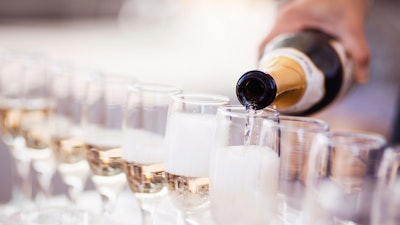
Tiny bubbles bursting in a drinker’s face and the bite of carbonation are all part of the experience when sipping champagne and sparkling wines. But how long can these drinks be stored in sealed bottles before they go flat? According to researchers reporting in ACS Omega, the answer depends on the container’s size. They estimate a 40-year shelf-life for 750-milliliter (25-ounce) bottles, and 82 and 132 years for 1.5-liter (50-ounce) and 3-liter (101-ounce) bottles, respectively.
Champagne and other sparkling wines get their bubbliness and tingly sensation from carbon dioxide, which is generated during a second round of fermentation that happens inside their bottles. Combining yeasts, sugar and wine launches the production of this gas and additional alcohol. Although the yeast die within a few months, complex aromas develop as the bottles age undisturbed for 15 months to several decades. But at the same time, the beverage is losing carbon dioxide, which is slowly escaping through the sealed metal caps or corks. So, Gérard Liger-Belair and colleagues wanted to answer the question: How does the size of the bottle influence how long you can age a champagne before it’s flat?
The researchers measured the carbon dioxide in different champagne vintages aged for multiple decades, and estimated the original amount of yeast-produced carbon dioxide. They found that the amount of gas inside the vessels, which were sealed with metal caps, decreased the longer the bottles aged. For example, the oldest vintage from 1974 lost the most carbonation, nearly 80%. Additionally, the team observed a correlation between the volume of a bottle and the carbon dioxide level, such that larger bottles retained gas substantially better than smaller ones.
In the end, the researchers developed a formula to calculate a bottle’s shelf life, or how long aged champagne would still spontaneously produce bubbles when poured in a glass. They predicted a shelf life of 40 years for standard 750-milliliter bottles, 82 years for 1.5-liter bottles and 132 years for 3-liter bottles, after which point the champagne would be flat. From their large selection of aged champagne, going back nearly 50 years, the researchers say they’ve shown how the drink’s bubbliness over time depends on the bottle’s size.
The authors acknowledge the contributions of samples from Champagne Castelnau. Some authors are employees at Champagne Castelnau and Pe-di, a manufacturer of stoppers for the wine industry.





















